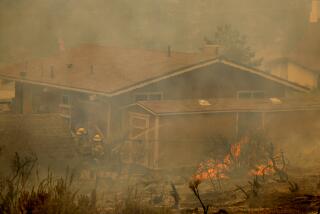The Angeles National Forest’s stubborn rebirth
From the start, there were indications that the U.S. Forest Service didn’t respond aggressively enough during the 2009 Station fire in the Angeles National Forest. Now there are signs that it moved too aggressively to plant a million seedlings in an attempt at post-fire reforestation.
As Times staff writer Louis Sahagun reports, only about a fourth of the pine and fir seedlings have survived so far, less than a third of the hoped-for number. Dry conditions this year would have made things difficult in any event, but many mistakes were surprisingly avoidable: planting in areas that experts now agree are too steep and rocky for tree survival; planting species that either aren’t native to the area or weren’t growing in those specific areas before; planting at too low an elevation; and planting more trees than typically grow in these areas.
The post-fire recovery of natural areas is a tricky business, and some human intervention is often needed. In this case, Forest Service officials say they had to act quickly and plant some less-than-ideal species because if they didn’t, native chaparral — dense thickets of mostly evergreen shrubs that have adapted to thrive in Southern California’s dry climate — would spring up too quickly and crowd out any young trees. What’s more, there weren’t enough seedlings of the type that had grown there naturally, and, at that moment, there was money available from Chevron through an environmental mitigation fund. The money to plant trees is to offset increased carbon emissions at Chevron’s El Segundo refinery, but these trees might not be what the burn area most needs.
Not all conifers are alike. This isn’t important just in terms of which ones are more likely to survive but also whether they provide habitat for key species. In this case, although the Forest Service appears to have acted with good intentions, it let expediency and convenience take precedence over wise forest management.
Despite the term “forest,” much of the land in the San Gabriel Mountains is covered in scrub and chaparral, with some oak woodlands and riparian areas and, at higher elevations, small clusters of trees such as big-cone Douglas fir. There were many expert and cautionary voices, including those at the California Chaparral Institute in San Diego County, telling the Forest Service that it was making a mistake with this quick tree-planting effort and that chaparral — native, hardy and quick to recover from fire — should have been allowed to cover more land naturally. As the effort goes forward, forest managers would be wise to pay more heed to those local experts.
More to Read
A cure for the common opinion
Get thought-provoking perspectives with our weekly newsletter.
You may occasionally receive promotional content from the Los Angeles Times.










